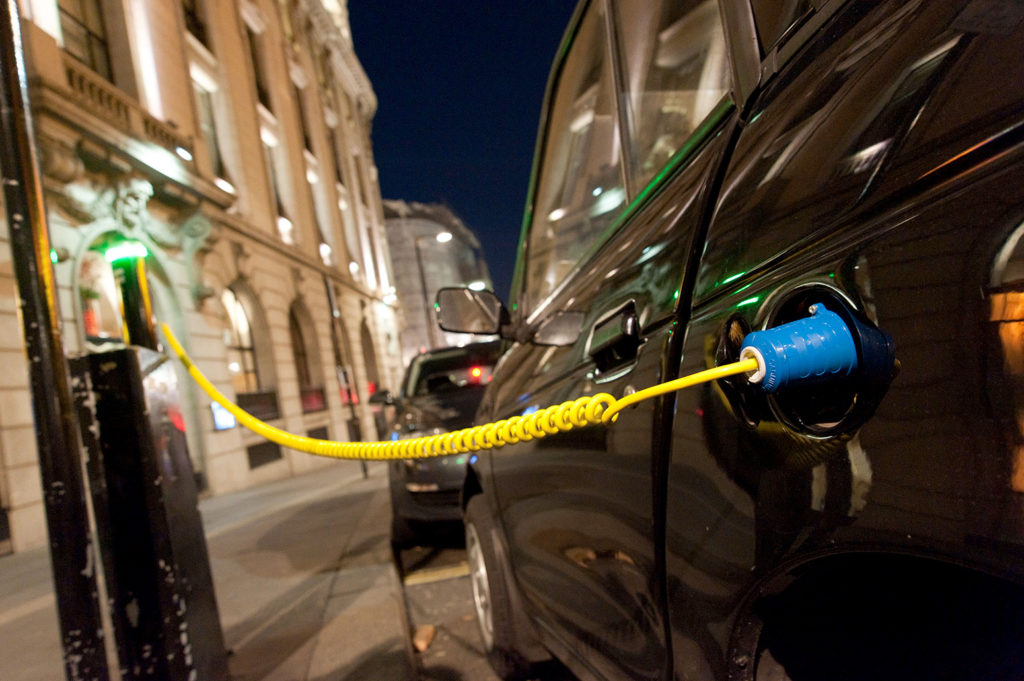
In-depth: UK can go low-carbon ‘at no extra cost’, say infrastructure advisors
Multiple Authors
07.10.18Multiple Authors
10.07.2018 | 5:07pmThe UK can have low-carbon electricity, heat and transport in 2050 at the same cost as today’s high-carbon energy system.
That’s according to the UK’s first National Infrastructure Assessment, published today by the National Infrastructure Commission (NIC). The wide-ranging 163-page report says this shift to greener energy is a “golden opportunity” and that ministers must act now to seize it.
The report sets out how the UK can move to “highly renewable, clean and low-cost energy”, while ending the use of gas for heating and shifting to 100% sales of electric vehicle (EVs) by 2030. It says a “quiet revolution” in renewable costs means government should prioritise wind and solar, echoing new scenarios from the Committee on Climate Change (CCC).
It also calls for investment in energy efficiency to triple and for no more than one new nuclear plant to be agreed before 2025.
On flooding – where the report only looks at England – it warns that the number of homes at substantial risk could increase by 40-50% across much of the country as the climate warms. It recommends a national flood protection standard to protect all English homes from “severe” events, with avoided costs more than offsetting the investment required.
To protect against rising risk of drought, it suggests cutting water leakage by half and investing in new reservoirs and water recycling.
“The recommendations are an affordable and deliverable strategy to modernise and strengthen the UK’s infrastructure networks,” the assessment says. “[They] will enable the UK to have a thriving digital economy, a low-cost low-carbon energy and waste network, clean air, successful cities, and resilience to extreme weather.”
Climate change
The commission was set up in 2015 by then-chancellor George Osborne, to provide independent, five-yearly assessments of the UK’s infrastructure needs. Today’s report is its first assessment. It covers transport, energy, water, waste, flooding and digital infrastructure out to 2050.
The commission’s objective is to “support sustainable economic growth across all regions of the UK, improve competitiveness and improve quality of life”. It also places great emphasis on climate change, which it says “will require a transformation in energy, waste and transport by 2050”.
Even with successful efforts to limit warming, it says: “The effects of climate change will still be felt, with higher average temperatures and increased risk of drought and flooding.”
Indeed, meeting the challenge of climate change is a central thread running through the commission’s report. It mentions “climate” 51 times and “carbon” 118 times, compared to 47 mentions for “population” and 17 for “economy”. In a foreword, NIC chair Sir John Armitt writes:
“The UK…needs low-cost energy and transport that doesn’t harm the planet…It needs water supply and flood defences that can respond to the risk of extreme floods and drought…[Our recommendations] will reduce our carbon emissions by leading the move to an energy system that is powered mainly by renewable energy
“[The recommendations] will also improve our quality of life by reducing air pollution, protecting our homes from floods, and making cities better places to live. The cost of driving will fall substantially if people can switch to electric vehicles. And they will help the environment by reducing waste that ends up in our landfill, incinerators and oceans.”
The full list of recommendations can be seen in the document embedded at the end of this article.
The government has committed to put the assessment before parliament and to respond to its recommendations within six months. This response will set out which recommendations the government will adopt and alternatives where it disagrees. “We look forward to the government adopting our programme of recommendations as policy,” Armitt writes.
The commission will monitor progress through annual reports. Its second national infrastructure assessment is due “around 2023”.
‘Low-cost’ transition
The shift to low-carbon power, heat and transport can be delivered at the same cost as today’s energy system, the NIC says. This conclusion does not include the climate benefits of reducing CO2 emissions – such as the reduced flooding costs discussed below – and is based on a series of technical papers published alongside the main report.
One paper covers the costs and options for heat decarbonisation – including hydrogen, biomass or electric heat pumps – discussed in more detail, below. Another looks at the system costs of an electricity mix that is up to 90% renewable in 2050, while meeting demand for EVs and potentially heat.
Overall, consumers currently pay an average of £1,850 per household per year for power, heat and transport fuel, the commission says. It says that a low-carbon energy system could deliver the same services at the same cost in 2050, while meeting UK climate goals.
“Decarbonisation doesn’t have to mean higher bills in total,” says Phil Graham, NIC chief executive. Within this, he says falling transport costs would balance rising heating costs. “Reducing emissions has often appeared costly and difficult, but this is no longer the case,” the report says.
1/ It has long been assumed that meeting the UK's carbon targets will drive up costs for consumers. An important finding of the @NatInfraCom NIA is that need not be the case, if the right decisions are taken now – and decarbonisation doesn't have to mean higher bills in total.
— Phil Graham (@mrphilgraham) July 10, 2018
This cost analysis assumes electricity demand remains the same as more efficient appliances offset increasing numbers of gadgets. It covers the cost of electric vehicle charging infrastructure and home heating appliances, as well as energy and fuel costs.
It excludes potential savings due to EVs having lower maintenance costs and excludes the “one-off costs” of installing cost-effective energy efficiency measures.
The commission’s analysis captures the system-wide effects of its recommendations, looking at the interactions between demand for heat, transport and electricity. It considers how this demand can be met in every half hour of the year, even if the sun is not shining and wind is not blowing.
More broadly, the commission calls for routine publication of good quality data on infrastructure costs and performance. It says it will measure the quality of existing UK infrastructure based on a comprehensive framework that includes CO2 emissions and other environmental externalities.
‘Highly renewable’ power
The commission says: “It is now possible to conceive of a low-cost electricity system that is principally powered by renewable energy sources.” It says at least 50% and up to 65% of electricity in 2030 should come from renewables.
[Note that the CCC says this range should be 58-73%. The difference chiefly relates to how much the UK relies on imported electricity, which the CCC says is risky and likely to be no cheaper than building extra renewables.]
The commission says the average cost of this highly renewable system between 2030 and 2050 would be comparable to investing heavily in new nuclear. However, it recommends a focus on wind and solar, where costs are more likely to fall even faster than expected.
This conclusion applies whether heat is predominantly supplied by electric heat pumps or whether it is met using low-carbon hydrogen and biomass, the report says. The higher cost of managing variable renewable output (blue chunks in the chart, below) is more than offset by lower capital costs for wind and solar, which translate into lower wholesale prices (yellow chunks).
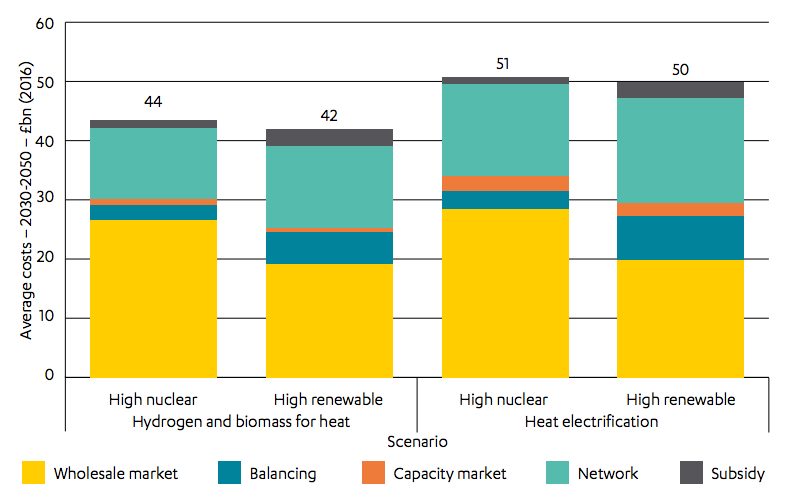
Average annual electricity system costs during 2030-2050, £bn, for different energy system decarbonisation pathways. Left columns: Heat decarbonised mainly with hydrogen and biomass. Right columns: Heat decarbonised mainly with electric heat pumps. Both scenarios assume that transport is mostly electrified. Source: National Infrastructure Assessment 2018.
Similarly, although government subsidies to the electricity system might be higher in the high-renewable scenarios, this would be more than offset by lower overall costs.
The commission cautions against giving too much weight to specific numbers from such long-term projections of cost. However, it says cost reductions for renewables have exceeded expectations. In contrast, it says: “Historical evidence suggest it is much less likely that nuclear costs will fall.
The commission examines a range of options to finance capital-intensive major projects, such as nuclear or carbon capture and storage (CCS). This covers public finance, currently being discussed for a new nuclear plant at Wylfa in Wales. It says the “apparently lower financing costs [of such an arrangement] represent a transfer, rather than a reduction, in risk.”
The commission concludes:
“Any assessment needs to recognise the full costs and risks. It should not be distorted by hidden costs or used to present costs as artificially lower…Given the balance of costs and risk, a renewables based system looks like a safer bet at present than constructing multiple new nuclear power plants. But a large amount of uncertainty does remain.”
(It is notable that NIC chair Sir John Armitt has a background in the nuclear industry. Former chair Lord Adonis, also formerly an advocate for nuclear, suggests both have changed their tune in response to changing evidence.)
In order to get to this highly renewable system, the commission recommends continuing the government’s existing electricity market mechanisms. Like the CCC, it says the government should hold further contracts for difference auctions to buy additional renewables in the 2020s.
It says that onshore wind and solar should be able to compete for support, whereas the most recent auctions have restricted access to less mature technologies, such as offshore wind. It says auctions should account for total system costs, though it acknowledges this is “very complex”.
There are also risks on the side of a highly renewable system, the NIC notes, around the cost of flexibility needed to accommodate variable renewables. Reiterating its 2016 findings, it says that a flexible grid is a “low-regrets investment” that reduces energy system costs “in all scenarios”.
The commission is dismissive of tidal power (“will remain an expensive technology in the future”), small nuclear reactors (“their benefits remain speculative”) and CCS in the power sector (“unlikely to form part of a cost competitive generation mix”).
Electric vehicles ‘take off’
The commission says that electric vehicles could soon enter the “take-off” stage in the UK. It says:
“Given their benefits for the environment, this is something government should encourage. A key way to do this is by ensuring that charging an electric vehicle is as easy as refilling a conventional vehicle, or even easier.”
With the right policies in place, consumer demand could see “close to 100%” of new car and van sales being electric by 2030, the commission says.
This outlook clashes with the government’s long-awaited “Road to Zero” transport strategy, published yesterday. This reiterated government plans to ban the sale of new petrol and diesel cars and vans from 2040, not including hybrid cars and vans.
The 2040 ban has previously been criticised for being years behind other countries – such as Norway’s 2025 target – and for putting UK leadership on electric cars at risk. Scotland plans to phase out new petrol and diesel car sales by 2032.
The CCC has also said a far earlier phase-out is needed to meet the UK’s climate targets. Responding today to the Road to Zero strategy, it says:
“Leaving open the possibility of sales of conventional hybrids and very short-range plug-in hybrids in 2040 and following years is inconsistent with the UK’s climate change commitments.
“To meet the Government’s stated goal of every car and van being zero emission in 2050, only pure battery electric vehicles and long-range plug-in hybrids can be sold after 2035, enabling the majority of journeys to be completed in electric mode.”
(The CCC says it will review the government’s transport strategy in a separate report in the coming months.)
The NIC says the government now needs to strongly back the roll out of a nationwide charging network to support the transition to electric cars. Charge points in rural and remote areas need particular support, since commercial investors are less likely to build in the short term.
Implementing this support by 2022 would deliver a core national network, it says, after which the private sector can take forward the delivery at scale as the pace of uptake increases.
The chart below shows the current proportion of built-up areas with a population over 20,000 with charge points (black) and without them (orange). Putting at least one rapid charger in each of these areas, at a total cost of around £10m, would represent a reasonable core network, the commission says.
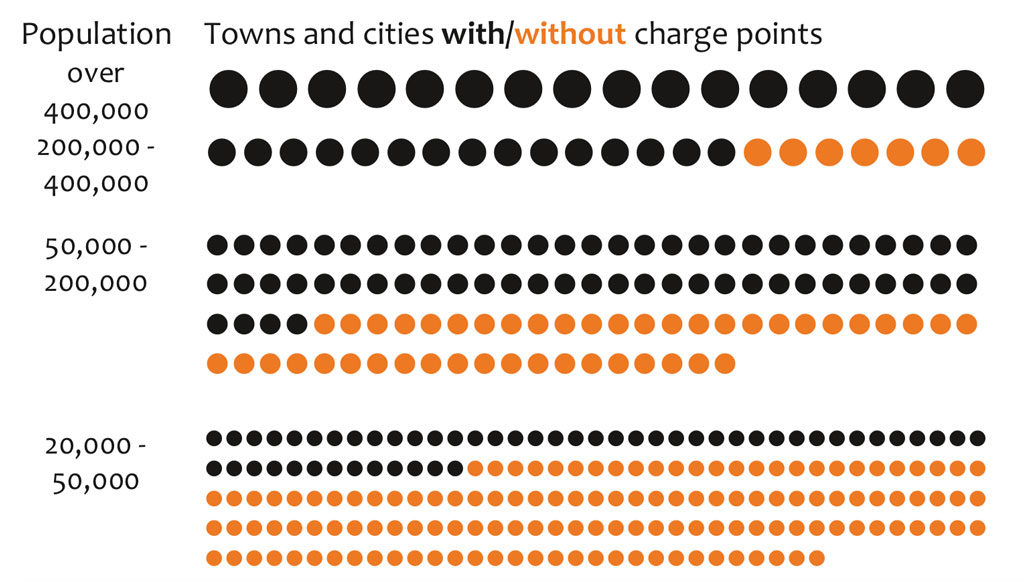
Proportion of built-up areas with at least one rapid charge point in June 2018 (by population). At least one rapid charger in each of those places would represent a reasonable core network, the NIC says. Source: National Infrastructure Assessment 2018.
The commission also considers the impact of electric cars and vans on electricity needs, suggesting 100% uptake could increase total annual demand by a quarter by 2050. This makes it “essential” to ensure the majority of chargers are smart, the commission says. Smart chargers should be “the default option” for home charging, supplemented by rapid chargers to help reduce range anxiety.
A crucial part of smart charging is managing and optimising how electric vehicle charge points and the electricity network interact. The commission recommends that energy regulator Ofgem should take on the role of regulating this “immediately”.
Meanwhile, government should place a requirement on local authorities to convert 5% of their parking spaces to electric vehicle charge points by 2020. This should increase to 20% by 2025, it says.
The advent of electric cars – and, thus, decline in fuel-duty revenues – will also mean payment for road use will “inevitabl[y]” change, the commission says. This presents a “huge opportunity” to design a fairer and more sustainable system which is more effective at reducing the negative impacts of driving, it adds.
One option is to introduce some kind of “road pricing” scheme. This would charge drivers according to road use, even though proposals have previously met with public opposition. Reforming how road use is paid for “cannot be avoided forever”, the commission says.
The new report also focuses a significant amount of attention on the benefits and changes which could come from the advent of connected and autonomous vehicles, such as increased vehicle sharing and reduced car ownership.
Even if there is still much uncertainty around autonomous vehicles and their impacts, the commission says government investment plans need to begin taking possible changes into account now. It advises the government to develop an “initial framework” to assess potential impacts before the early 2020s.
‘No more’ gas heating
Around a fifth of the UK’s greenhouse gas emissions come from heating, the commission says. This means “heating must no longer be provided by natural gas, a fossil fuel,” if the UK is to meet emissions targets, it says.
Emissions from heat and hot water provision need to drop to around a 10% of their current levels by 2050 to be compatible with the UK’s emission goals, according to analysis from consultancies Element Energy Limited and E4Tech, produced to inform the NIC assessment.
The government now needs to establish the feasibility of low-carbon alternatives to oil and gas for heating, the commission says. There are two main options on the table: converting existing grids to use hydrogen gas from zero-carbon sources, or heat pumps, which increase the efficiency of using electricity to supply heat.
By the 2020s, the government will need to make a decision on whether to maintain and convert the gas grid, or completely phase it out, the commission says. A coherent government programme is, therefore, needed to gather the evidence for this decision.
For hydrogen, the safety case for its use as a replacement for fossil gas need to be established, the commission says, followed by community-level trials by 2021. If these are successful, the government should implement a trial to supply at least 10,000 homes by 2023, including hydrogen production with carbon capture and storage (CCS).
For heat pumps, the government should establish an “up-to-date evidence base” on their performance within the UK building stock by 2021, including the scope for future reductions in their cost.
The Element Energy Limited and E4Tech analysis shows that, currently, all routes to low-carbon heat are more expensive than the status quo. However, the commission says, the impacts of this cost will be offset by reduced energy costs in other areas, especially through the electrification of transport.
The commission’s recommendations chime with other analysis pointing to the need for the UK to at last begin exploring its options for decarbonising heat in earnest.
The CCC’s recent progress report highlighted housing and heat as one of the key areas in urgent need of new policy. This report was in turn informed by a separate analysis from Imperial College London, which also urged the government to address the uncertainties in heat decarbonisation through pilot trials.
The commission says energy efficiency can mitigate some of the emissions from heat. Its analysis suggests that there are more than 21m individual improvements to buildings in England that could be made, together saving billions of pounds. This includes insulating lofts in 10m homes, floors in six million and walls in almost five million.
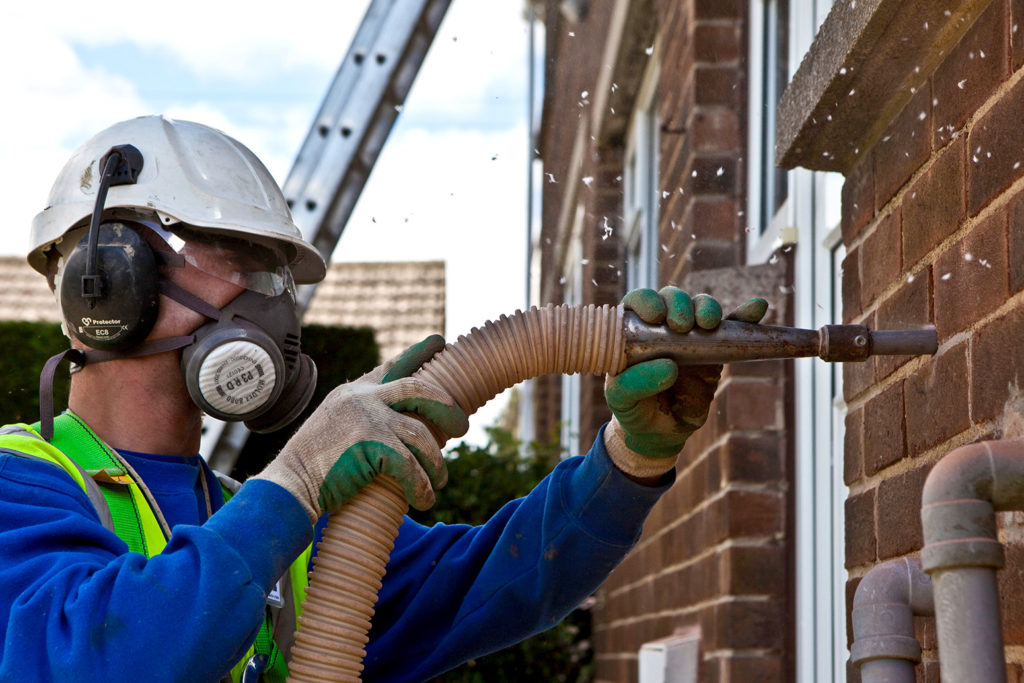
Cavity wall insulation being installed in a home in Kirklees, UK. Credit: Andrew Aitchison / Alamy Stock Photo.
It calls for £3.8bn investment over the next 12 years for improvements to social housing. This would meet the government’s own stated ambition of ensuring social rented properties reach at least Energy Performance Certificate (EPC) band C by 2030, the commission says.
The commission also says trials of innovative efficiency approaches are needed for owner-occupied houses, while a plan to tighten regulations in private rented homes should be set out by the end of 2018.
By 2020, the installation of energy efficiency improvements should have reached a rate of 21,000 per week, the commission says, double the current rate of around 9,000 per week.
The commission also makes a series of recommendations on waste, including new national rules for what can and cannot be recycled. In particular, it says more food waste should be collected and used to generate biogas using anaerobic digesters. This could also be used as a low-carbon substitute for fossil gas in heat and even, potentially, aviation.
Reducing flood risk
The commission’s report recognises that “climate change will continue to make extreme weather events such as floods…more likely in future years”. Previous research covered by Carbon Brief finds that climate change could make river flooding more unpredictable and severe across Europe, with UK cities, including Carlisle, Glasgow and Chester, facing the largest increase in flood risk.
The cost of flooding is often higher in urban than rural areas because cities are more built up and densely populated. Cities in the UK are also less likely to incorporate natural flood defences, such as marshland.
Flood risk management is devolved to Scotland, Wales and Northern Ireland. Because of this, the commission’s analysis of flood risk only covers England.
The charts below show the expected increase in the number of homes facing a more than 0.5% chance (one in 200) each year of being flooded across England by 2050, when compared to present day.
The expected increase is shown for two scenarios: one with “low” population growth and global warming of 2C above pre-industrial levels, which is the limit set by the Paris Agreement, (left), and another with “high” population growth and global warming of 4C (right). The “low” growth scenario expects the population to reach 73.7m by 2050, while the “high” scenario expects the population to reach 81.3m. (The population is currently around 66.6m.)
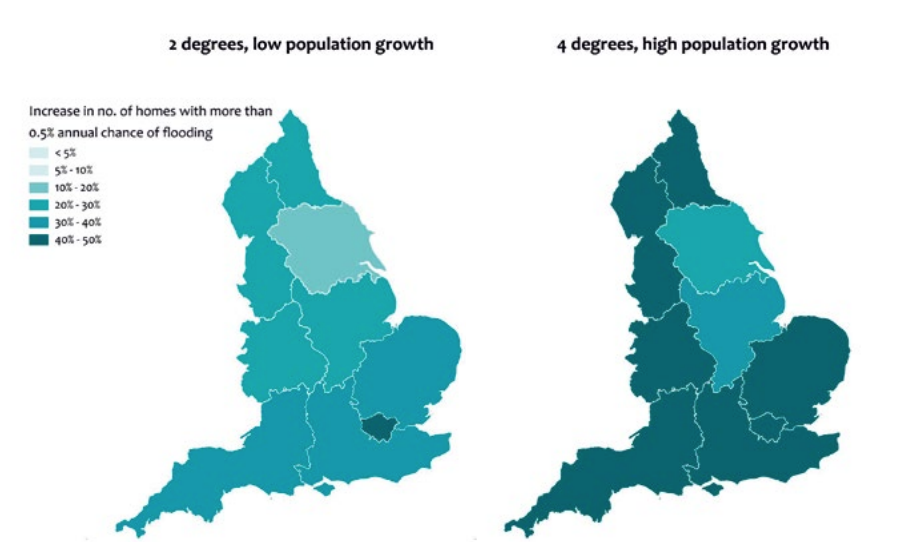
Expected increase in the number of homes facing a more than 0.5% annual chance of flooding in 2050 under a scenario of low population growth and global warming of 2C above pre-industrial levels (left) and a scenario of high population growth and 4C of global warming (right). Source: National Infrastructure Assessment 2018.
The charts suggest that, under the 2C scenario, the number of homes facing a one-in-200 chance each year of being flooded is likely to increase by at least 20% across much of the country, with London facing increases of up to 40-50%. Under the 4C scenario, the number of homes at substantial risk of flooding could increase by 40-50% across much of England.
In light of these risks, the commission has proposed, for the first time, that the government set a nationwide minimum standard for flood resilience. This minimum standard would mean that “everyone should receive the same level of protection” from flooding, the report says. However, the advisors add that the standard set should not be statutory or imply a right to compensation if not achieved.
The commission suggests that the government should aim to set a standard of protecting all properties from “severe” flooding by 2050. “Severe” is used to describe floods that currently occur once in every 200 years (annual likelihood of 0.5%).
However, in large cities – which are defined as having more than 500,000 people – the minimum standard should be to protect against floods with an annual likelihood of 0.1%, according to the report.
The report says that achieving a nationwide minimum standard would require investment in flood barriers, “green infrastructure” such as marshland and forests, better spatial planning and measures to improve the resilience of individual properties.
At present, the UK government has pledged to spend £4.4bn (around £700-800m a year) on improving flood defences in England between 2015-16 and 2020-21.
The chart below shows the estimated annual cost of maintaining current flooding resilience (first bar) and increasing resilience standards between 2020 and 2050. On the chart, the estimated costs under the 2C scenario are shown in black, while the estimated additional costs posed by the 4C scenario are shown in blue.
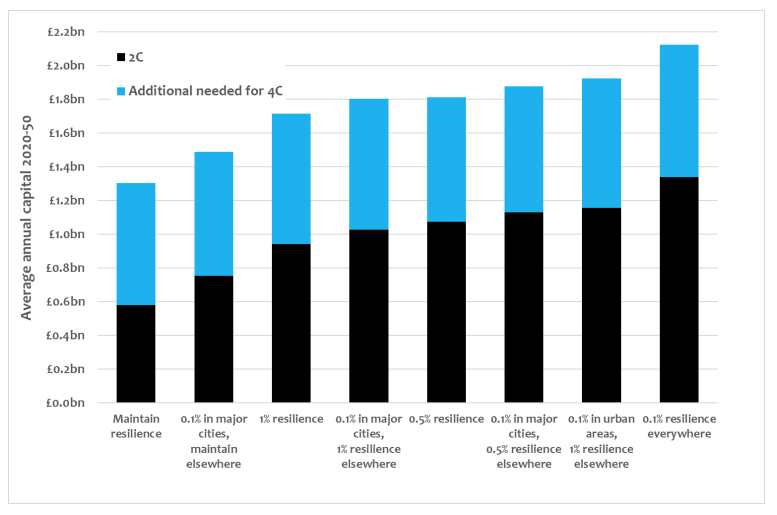
Expected average annual cost of maintaining different levels of flood resilience across England from 2020-2050. Costs are given for scenarios of 2C of global warming (black) and 4C of global warming (blue). Source: Technical annex: Flood modelling, July 2018
The chart shows that implementing the suggested flood resilience standards (third bar from the right) would cost an additional £1.1bn per year between 2020 and 2050, if warming is limited to 2C. However, if warming reaches 4C, the additional cost could reach around £1.8bn per year.
However, the report notes that this cost is likely to be offset by savings made from avoiding property damage, emergency response costs, death and injuries, mental-health effects and impacts on infrastructure, transport, schools and leisure.
Under the 2C scenario, the total net benefit of implementing the minimum resilience standards is likely to be around £250-500m, according to the analysis. The commission does not offer a similar figure for the 4C scenario, but notes that the net benefits are likely to be “much higher” than under the 2C scenario.
Preparing for drought
The report also acknowledges that parts of England are likely to face an increased risk of drought as a result of “climate change and an increased population”. Previous research suggests that changing rainfall patterns as a result of climate change could drive up drought risk across many UK cities, especially those in southeast England.
Drought increases will require the country to use more water to meet demand, the report notes. The analysis shows that, to maintain current levels of drought resilience until 2050, England would need an extra 2,700-3,000m litres of water a day. This would require England to up its daily water supply by around one-quarter.
Protecting the nation from the increased risk of “extreme” drought – defined as droughts that currently occur once in every 50 years – would require an additional 500-1,000m litres a day, the analysis finds.
The commission also notes that “limited cooperation between water companies” is likely to heighten the effect of drought on the water supply in the coming decades:
“As a result a serious drought would lead to an unacceptably high risk of severe supply limitations; homes and businesses could even be completely cut off.”
The commission recently published a standalone report, “Preparing for a drier future: England’s water infrastructure needs”, which sets out its suggestions for meeting required increases in water demand.
The report suggests methods for boosting supply, such as through the increased use of reservoirs and water recycling, and for reducing current demand, largely by cutting the leakage from water supply systems by half. At present, close to 20% of the nation’s water supply is lost through leakage, according to the report.
-
In-depth: UK can go low-carbon ‘at no extra cost’, say infrastructure advisors
-
National Infrastructure Commission sketches UK’s low-carbon future


